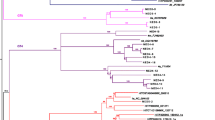Abstract
The genotype of the hepatitis C virus (HCV) strain infecting a given patient is an important predictive factor for the clinical outcome of chronic liver disease and its response to anti-viral therapeutic agents. We herein sought to develop a new easy, sensitive and accurate HCV genotyping method using annealing genotype-specific capture probes (AGSCP) in an automation-friendly 96-well plate format. The validation of our new AGSCP was performed using the Standard HCV Genotype Panel. We then used both our AGSCP and the commercially available INNO-LiPA assay to analyze the HCV genotypes from 111 Korean patients. Discordant results were analyzed by direct sequencing. AGSCP successfully genotyped the standard panel. The genotypes of 111 patient samples were also obtained successfully by AGSCP and INNO-LiPA. We observed a high concordance rate (93 matched samples, 83.8%) between the two assays. Sequencing analysis of the 18 discordant results revealed that the AGSCP had correctly identified 12 samples, whereas the INNO-LiPA had correctly identified only 6. These results collectively indicate that AGSCP assay is a convenient and sensitive method for large-scale genotyping, and it may be a promising tool for the determination of HCV and other genotypes in clinical settings.
Similar content being viewed by others
References
Ansaldi, F., F. Torre, B.M. Bruzzone, A. Picciotto, P. Crovari, and G. Icardi. 2001. Evaluation of a new hepatitis C virus sequencing assay as a routine method for genotyping. J. Med. Virol. 63, 17–21.
Arens, M. 2001. Clinically relevant sequence-based genotyping of HBV, HCV, CMV, and HIV. J. Clin. Virol. 22, 11–29.
Brechot, C. 1994. Hepatitis C virus genetic variability: clinical implications. Am. J. Gastroenterol. 89, 41–47.
Bukh, J., R.H. Purcell, and R.H. Miller. 1992. Sequence analysis of the 5′ noncoding region of hepatitis C virus. Proc. Natl. Acad. Sci. USA 89, 4942–4946.
Choo, Q.L., K.H. Richman, J.H. Han, K. Berger, C. Lee, C. Dong, C. Gallegos, D. Coit, A. Medina-Selby, P.J. Barr, A.J. Weiner, D.W. Bradley, G. Kuo, and M. Houghton. 1991. Genetic organization and diversity of the hepatitis C virus. Proc. Natl. Acad. Sci. USA 88, 2451–2455.
Di Bisceglie, A.M., S.E. Order, J.L. Klein, J.G. Waggoner, M.H. Sjogren, G. Kuo, M. Houghton, Q.L. Choo, and J.H. Hoofnagle. 1991. The role of chronic viral hepatitis in hepatocellular carcinoma in the United States. Am. J. Gastroenterol. 86, 335–338.
Furion, M., L. Simoncini, M. Gatti, F. Baldanti, M.G. Revello, and G. Gerna. 1999. HCV genotyping by three methods: analysis of discordant results based on sequencing. J. Clin. Virol. 3, 121–130.
Kim, C.J., K.S. Shin, W.-Y. Kim, D.S. Lim, S.K. Yoon, Y.M. Park, B.-S. Kim, S.-K. Jang, and M.-J. Cho. 1995. Genotype distribution and comparison of the putative envelope region of hepatitis C virus from Korean patients. J. Med. Virol. 46, 380–386.
Le Pogam, S., F. Dubois, R. Christen, C. Raby, A. Cavicchini, and A. Goudeau. 1998. Comparison of DNA enzyme immunoassay and line probe assays (Inno-LiPA HCV I and II) for hepatitis C virus genotyping. J. Clin. Microbiol. 36, 1461–1463.
Mellor, J., E.A. Walsh, L.E. Prescott, L.M. Jarvis, F. Davidson, P.L. Yap, and P. Simmonds. 1996. Survey of type 6 group variants of hepatitis C virus in Southeast Asia by using a core-based genotyping assay. J. Clin. Microbiol. 34, 417–423.
Mondelli, M.U. and E. Silini. 1999. Clinical significance of hepatitis C virus genotypes. J. Hepatol. 31, 65–70.
Ogata, N., H.J. Alter, R.H. Miller, and R.H. Purcell. 1991. Nucleotide sequence and mutation rate of the H strain of hepatitis C virus. Proc. Natl. Acad. Sci. USA 88, 3392–3396.
Ohno, O., M. Mizokami, R.R. Wu, M.G. Saleh, K. Ohba, E. Orito, M. Mukaide, R. Williams, and J.Y.N. Lau. 1997. New hepatitis C virus (HCV) genotyping system that allows for identification of HCV genotypes 1a, 1b, 2a, 2b, 3a, 3b, 4, 5a, and 6a. J. Clin. Microbiol. 35, 201–207.
Pozzato, G., S. Kaneko, M. Moretti, L.S. Croce, F. Franzin, M. Unoura, L. Bercich, C. Tiribelli, M. Crovatto, G. Santini, and K. Kobayashi. 1994. Different genotypes of hepatitis C virus are associated with severity of chronic liver disease. J. Med. Virol. 43, 291–296.
Simmonds, P., J. Mellor, T. Sakuldamrongpanich, C. Nuchaprayoon, S. Tanprasert, E.C. Holmes, and D.B. Smith. 1996. Evolutionary analysis of variants of hepatitis C virus found in South-East Asia: comparison with classifications based upon sequence similarity. J. Gen. Virol. 77, 3013–3024.
Smith, D.B., J. Mellor, L.M. Jarvis, F. Davidson, J. Kolberg, M. Urdea, P.-L. Yap, P. Simmonds, and The International HCV Collaborative Study Group. 1995. Variation of the hepatitis C virus 5’ non-coding region: implications for secondary structure, virus detection and typing. J. Gen. Virol. 76, 1749–1761.
Stuyver, L., R. Rossau, A. Wyseur, M. Duhamel, B. Vanderborght, H. Van Heuverswyn, and G. Maertens. 1993. Typing of hepatitis C virus isolates and characterization of new subtypes using a line probe assay. J. Gen Virol. 74, 1093–1102.
Stuyver, L., A. Wyseur, W. Van Arnhem, F. Hernandez, and G. Maertens. 1996. Second-generation line probe assay for hepatitis C virus genotyping. J. Clin. Microbiol. 34, 2259–2266.
Zein, N.N. 2000. Clinical significance of hepatitis C virus genotypes. Clin. Microbiol. Rev. 13, 223–235.
Zeuzem, S. 2001. What is (cost) effective in patients with chronic hepatitis C virus infection? Eur. J. Gastroenterol. Hepatol. 13, 473–476.
Zhang, Z.X., Z.B. Yun, M. Chen, A. Sönerborg, and M. Sälberg. 1995. Evaluation of a multiple peptide assay for typing of antibodies to the hepatitis C virus: relation to genomic typing by the polymerase chain reaction. J. Med. Virol. 45, 50–55.
Author information
Authors and Affiliations
Corresponding author
Rights and permissions
About this article
Cite this article
Rho, J., Ryu, J.S., Hur, W. et al. Hepatitis C virus (HCV) genotyping by annealing reverse transcription-PCR products with genotype-specific capture probes. J Microbiol. 46, 81–87 (2008). https://doi.org/10.1007/s12275-007-0121-8
Received:
Accepted:
Published:
Issue Date:
DOI: https://doi.org/10.1007/s12275-007-0121-8




